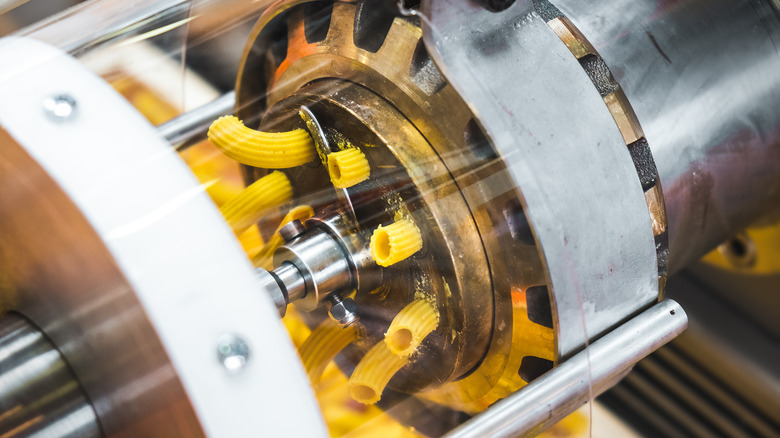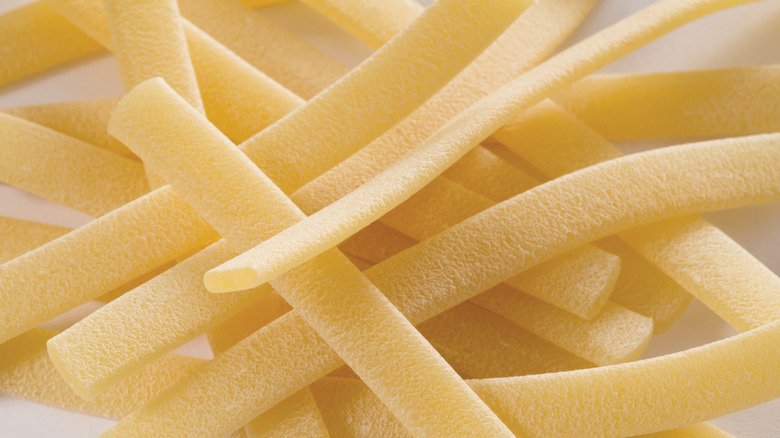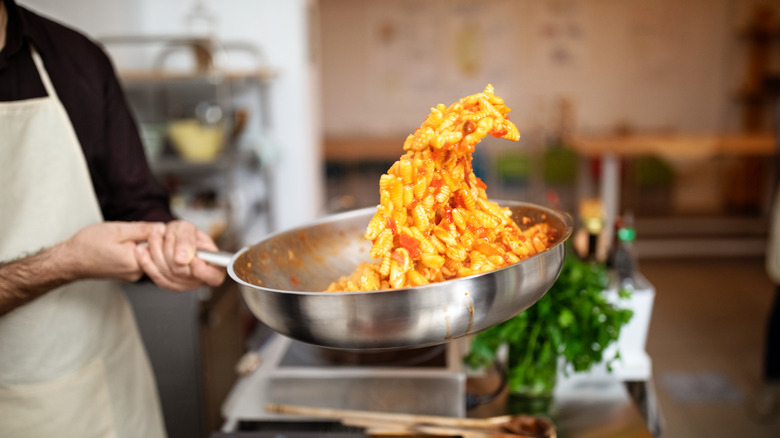What It Means When Pasta Is 'Bronze Cut' And Why It's A Green Flag
As it turns out, the pasta you buy in the grocery store isn't hand rolled by hundreds of Italian nonnas (it's okay to be disappointed). Instead, the pasta is extruded — raw, soft pasta dough is pushed out of a mold into shapes. Some of those shapes are long and round, becoming spaghetti, some of those shapes are twisty, getting cut into pasta varieties like gemelli, and some are round and hollow, getting cut into short stout shapes like ziti. It's really quite satisfying to watch, if your YouTube queue of calming videos ever takes a starchy turn.
When pasta is extruded like this, it is called die-cut pasta. These days, there are two primary materials used in this machinery: Teflon and bronze. Teflon extruded pasta is very smooth, as you might expect. Bronze cut pasta, on the other hand, has a lot more texture. It can look almost shrunken and wrinkled out of the box, like good, fine-grained leather. This is the texture that producers, chefs, and consumers are looking for; because it is rougher, it better approximates hand-rolled pasta. It is widely considered to have a better mouth feel than teflon extruded pasta.
Bronze cut pasta is technically the old-fashioned way, but it's making a comeback. It has become widely available, rather than only being offered by expensive and less common specialty brands, as home cooks learn that bronze cut pasta is just, well, better.
The deal with bronze cut pasta
Until Teflon was discovered in 1938, bronze was the only reliable material for die cut pasta because it didn't rust and it dispersed heat better. Once Teflon was invented, pasta factories found that it made for faster extrusion without cooking the dough as well as stronger pasta, fewer contaminated samples, and less wear on the dies — all good things for a factory. Slick-surfaced and yellow pasta extruded through Teflon has been the standard for decades, making bronze cut pasta an artisan product rather than a standard one. Why would a factory make less pasta that's 30% more breakable in a day? Because it's more enjoyable to eat.
The executive chef of Barilla, Lorenzo Boni, told the Center for Advancement of Foodservice Education that it's "all about the taste experience." Some may say that bronze cut pasta's texture helps it to better hold onto sauce, but based on a few informal experiments by YouTube foodie Adam Ragusea, that may not be strictly true. Not unless you're making pasta properly by splashing some pasta water into the sauce and finishing the noodles in the sauce, of course. Some food experts believe that bronze cut pasta releases more starch into the cooking water than smooth pasta; more starch in the pasta water means it will cling better to the pasta before it hits your plate (and your mouth).
From the shelf to your kitchen
It's no secret that the food industry is on an extended pendulum swing retreating from the highly processed convenience foods of the mid-twentieth century. More and more consumers are looking for authentic ingredients made the old-fashioned way — just look at the recent sourdough bread and fermentation trends as examples.
Not only is bronze cut pasta literally more authentic to the old-fashioned way of making pasta, it also looks more authentic. Some manufacturers, like Barilla, play up the bronze die effect even more. Chef Lorenzo Boni said Barilla actually micro engraves the bronze dies to encourage even more texture in the final pasta. It's possible that this additional roughness creates better pasta, but it's equally likely that it's a marketing move rather than a culinary one. It makes the texture instantly recognizable, visually justifying its slightly higher prices. Still, if more people are buying bronze cut pasta, it becomes more prevalent — and more home kitchens will benefit.
The additional starch in the pasta water from bronze cut pasta makes it the best choice for dishes that really rely on its emulsification properties, like cacio e pepe, though it's going to improve any sauced pasta dish. The bronze cut pasta revival means that — with the exception of people who rinse their pasta before saucing it — the sauce is going to stick to the pasta better in many more kitchens, making for generally better pasta dishes.


